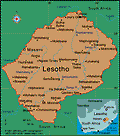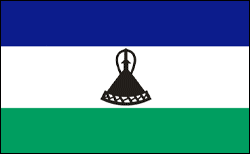Lesotho
Facts & Figures

-
Sovereign: King Letsie III (1996)
Prime Minister: Pakalitha Mosisili (2015)
Total area: 11,718 sq mi (30,350 sq km)
Population (2014 est.): 1,942,008 (growth rate: 0.34%); birth rate: 25.92/1000; infant mortality rate: 50.48/1000; life expectancy: 52.65
Capital and largest city (2011 est.): Maseru 239,000
Monetary unit: Maluti
Languages: English, Sesotho (both official); Zulu, Xhosa
Ethnicity/race: Sotho 99.7%, Europeans, Asians, and other 0.3%
Religions: Christian 80%, indigenous beliefs 20%
National Holiday: Independence Day, October 4
Literacy rate: 89.6% (2010 est.)
Economic summary: GDP/PPP (2013 est.): $4.265 billion; per capita $2,200. Real growth rate: 4.1%. Inflation: 5.0%. Unemployment: 25% (2008). Arable land: 10.14%. Agriculture: corn, wheat, pulses, sorghum, barley; livestock. Labor force: 874,200 (2013); 86% of resident population engaged in subsistence agriculture; roughly 35% of the active male wage earners work in South Africa; industry and services 14%. Industries: food, beverages, textiles, apparel assembly, handicrafts, construction, tourism. Natural resources: water, agricultural and grazing land, diamonds, sand, clay, building stone. Exports: $941.2 million (2013 est.): manufactures 75% (clothing, footwear, road vehicles), wool and mohair, food and live animals. Imports: $2.148 billion (2013 est.): food; building materials, vehicles, machinery, medicines, petroleum products. Major trading partners: U.S., Canada, UK, Hong Kong, China, India, South Korea, Germany (2004).
Member of Commonwealth of Nations
Communications: Telephones: main lines in use: 43,100 (2012); mobile cellular: 1.312 million (2011). Broadcast media: 1 state-owned TV station and 2 state-owned radio stations; government controls most private broadcast media; satellite TV subscription service available; transmissions of multiple international broadcasters obtainable (2008). Internet Service Providers (ISPs): 11,030 (2012). Internet users: 76,800 (2009).
Transportation: Railways: none. Highways: total: 5,940 km; paved: 1,069 km; unpaved: 4,871 km (2011). Ports and harbors: none. Airports: 24 (2013).
International disputes: South Africa has placed military units to assist police operations along the border of Lesotho, Zimbabwe, and Mozambique to control smuggling, poaching, and illegal migration.

